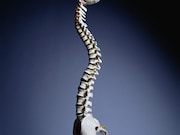Peripheral CT indices address risk for fracture contributed by changes in bone microarchitecture
FRIDAY, Nov. 30, 2018 (HealthDay News) — High-resolution peripheral quantitative computed tomography (HR-pQCT) indices improve prediction of fracture beyond bone mineral density and Fracture Risk Assessment Tool (FRAX) scores in older adults, according to a study published online Nov. 28 in The Lancet Diabetes & Endocrinology.
Elizabeth J. Samelson, Ph.D., from Hebrew SeniorLife in Boston, and colleagues examined participants in eight cohorts to estimate the correlation between HR-pQCT bone indices and incidence of fracture. Data were included for 7,254 individuals (mean baseline age, 69 years).
The researchers found that 11 percent of participants had incident fractures; 86 percent of those with fractures had femoral neck T scores greater than −2.5. Peripheral skeleton failure load had the greatest association with risk for fracture after adjustment for age, sex, cohort, height, and weight (hazard ratios for tibia and radius, 2.40 and 2.13, respectively, per one standard deviation decrease). For other bone indices, hazard ratios ranged from 1.12 per one standard deviation increase in tibia cortical porosity to 1.58 per one standard deviation decrease in radius trabecular volumetric bone density. The associations were reduced but remained significant for most bone parameters after further adjustment for femoral neck adjusted bone mineral density and FRAX score.
“Assessment of cortical and trabecular bone microstructure may be useful in those who would not otherwise have been identified as being at high risk for fracture,” a coauthor said in a statement.
Several authors disclosed financial ties to the pharmaceutical and medical device industries; one author is cofounder of Numerics88 Solutions, which provides estimates of bone strength from HR-pQCR images.
Abstract/Full Text (subscription or payment may be required
Editorial (subscription or payment may be required)
Copyright © 2018 HealthDay. All rights reserved.








